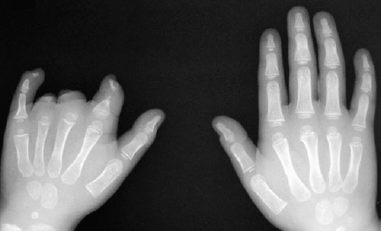79
Hypoplastic Digits and Hands
Scott H. Kozin
History and Clinical Presentation
A 4-year-old boy presented with a congenital anomaly of his left hand (Fig. 79–1). He is the product of a full-term pregnancy, born via cesarean section. There were no problems during pregnancy or delivery. The child is right hand dominant, but he is able to grasp cups and utensils with his left hand. He is otherwise healthy and has attained his developmental milestones (e.g., sitting, walking, and talking) at the normal time. Past medical history is positive for a heart murmur at birth that has resolved over time.
Physical Examination
The patient is a healthy-appearing and attentive child with full motion of his left shoulder, elbow, forearm, and wrist. The left thumb is normal in size and motion when compared with the right. The index, long, ring, and small digits are diminished in size (Fig. 79–1). The index finger has a remnant of proximal phalanx present and a small nail. The long and ring fingers have no bony support distal to the metacarpal. There are skin tubes distal to the metacarpal with small nails present. The small digit is larger than the other fingers with full metacarpophalangeal joint motion, but no active or passive motion of the proximal interphalangeal joint. The distal phalanx is inclined in a radial direction and the distal interphalangeal joint motion is 0 to 40 degrees. The right upper extremity and legs are normal. No chest wall abnormalities were noted. No amniotic bands were present on any of the extremities.

Figure 79–1 (A) Dorsal view of a 4-year-old child with small index, long, and ring digits and rudimentary nails. (B) Palmar view of shortened digits and radial deviation of the small finger.

PEARLS
- Children with hypoplastic digits are often capable of remarkable function.
- A thumb and digit with adequate length and mobility can provide sufficient pinch and grasp.
- Nonvascularized toe transfer is best indicated in aphalangia.
PITFALLS
- Digital lengthening is difficult and requires frequent monitoring to avoid potential complications.
- On-top plasty requires extensive neurovascular dissection to prevent vascular compromise of digit.
- Toe-to-hand transfer in the congenially anomalous hand is difficult.
Diagnostic Studies
Radiographs of both hands revealed several abnormalities of the left hand (Fig. 79–2). The thumb appeared normal in size and bony configuration. The fingers had normal metacarpals with considerable deficiencies at the phalangeal level. The index digit had a metacarpophalangeal joint with a remnant of proximal phalanx. The long and ring fingers had no phalanges. The small digit had normal-appearing joints and radial deviation of the distal interphalangeal joint.
Differential Diagnosis
Constriction band syndrome
Hypoplastic digits
Brachydactyly
Poland’s syndrome
Constriction band syndrome is a result of entrapment of developing embryonal tissue by fetal lining and can affect the upper extremity in a variety of ways. Mild band formation can cause simple constriction rings that are merely a cosmetic deformity. Severe bands can cause autoamputation of the digits, which requires treatment similar to severe hypoplasia. The diagnosis of constriction band requires the presence of a constriction band either in the hand or elsewhere. Brachydactyly usually refers to a shortened digit with the normal complement of bones and is a specific form of hypoplasia. Poland’s syndrome is usually sporadic in occurrence and combines hand hypoplasia with chest wall abnormalities. The most common hand anomaly is symbrachydactyly (syndactyly combined with brachydactyly), and the typical chest abnormality is ipsilateral absence of the sternocostal portion of the pectoralis major muscle.
Diagnosis
Digital Hypoplasia
Hypoplasia can result from numerous anomalies including failure of formation, failure of differentiation, undergrowth, or constriction band syndrome. Hypoplastic digits is a general term that reflects deficiencies of the thumb and/or fingers. Thumb hypoplasia is often associated with preaxial longitudinal deficiencies (i.e., radial clubhand) and classified as a specific entity. The terminology for hypoplastic fingers is confusing and inconsistent. The term hypoplastic digits is best reserved for fingers that cannot be specifically classified (e.g., brachydactyly) or secondary to a known cause (e.g., amniotic bands or posttraumatic).
Nonsurgical Management
The initial treatment of digital hypoplasia is nonoperative. The child needs to be evaluated and the parents educated about this congenital anomaly. The emotional distress of the parents should be addressed during the initial visits. We attempt to explain to the parents that most congenital anomalies occur during weeks 4 and 8 of gestation as the developing limb bud grows. The defect most likely affected the covering of the limb (apical ectodermal ridge), which caused a malformation of the underlying structures. This abnormality may have occurred prior to their knowledge of the pregnancy. In addition, the cause of the vast majority of congenital abnormalities is unknown, and we will likely never know what resulted in most congenital anomalies. We also stress that the parents treat the child as normal as possible, as the child does not know he or she is different and will be highly adaptive in achieving those tasks necessary for function. These adaptive maneuvers should not be discouraged during the developmental stages, as the child attempts to achieve bimanual and prehensile function.
Children with varying degrees of hypoplastic digits in the same hand may be able to achieve good functional pinch and grasp. This is especially true if the thumb is normal and another digit is available to act as a post. In this child, the thumb was able to oppose the small digit for oppositional pinch and grasp (Fig. 79–3). These movements were easily performed despite symphalangism (proximal interphalangeal joint ankylosis) and clinodactyly (radial deviation of the distal interphalangeal joint) of the small finger. Children who are this functionally adept are not surgical candidates.










